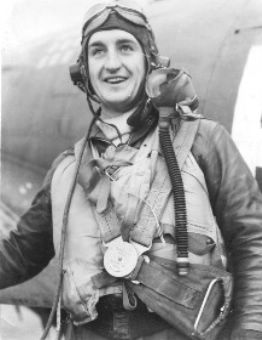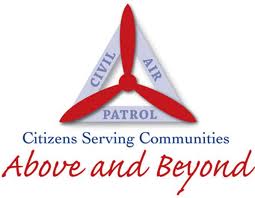Our Namesake!
 Francis "Gabby" Gabreski almost didn't make it through flight school. Almost 12 years later, he would become the first Air Force fighter pilot to become an ace in both World War II and the Korean conflict.
Francis "Gabby" Gabreski almost didn't make it through flight school. Almost 12 years later, he would become the first Air Force fighter pilot to become an ace in both World War II and the Korean conflict.
But first he had to earn his wings. An uneasy pilot at best, Gabreski didn't get along with his instructor at Parks Air College, a civilian program the Army used for its novice cadets in 1940. He knew he wasn't progressing as quickly as other students in the Stearman PT-17 biplane, but managed to survive an "elimination flight" conducted by Capt. Ray Wassel, an Army pilot. Wassel told him to step into the plane and give it his best. He flew well enough for Wassel to conclude that he was a marginal pilot, but could probably do better with a new instructor. He was right.
Gabreski was most relieved not to let his parents down by failing. Both of them had emigrated from Poland to Oil City, Pa. in the early 1900s. His father owned and operated a market, putting in 12-hour days. Like many immigrant-owned businesses in those days, the whole family worked at the market. But Gabreski's parents had dreams for him, including attending Notre Dame University. He did so in 1938, but, unprepared for real academic work, almost flunked out during his freshman year. During his second year at Notre Dame, Army Air Corps recruiters visited the campus. Gabreski went to hear them, primarily because his friends were going. The Army's enticing offer impressed him and he enrolled, reporting in July 1940.
After finally making it through primary flight training, he graduated from basic flight training at Gunter Army Air Base, Ala., then from Maxwell Field, Ala., for advanced training. He graduated from Maxwell in March 1941 and was commissioned as a second lieutenant. His parents proudly attended the ceremony.

Gabreski was assigned to fly fighter planes at Wheeler Field on Oahu, Hawaii. There he flew Curtiss P-40s and P-36s, powerful single-seat fighters. On the morning of Dec. 7, 1941, young Grabreski was shaving when he heard some explosions. Looking out his window, he saw a gray monoplane with red circles and fixed landing gear flying overhead. He realized the Japanese were attacking. In the aftermath of the Pearl Harbor attack, Gabreski realized that his life had changed. His crystal-clear days flying above the Hawaiian Islands and carefree evenings at the Wheeler Officers' Club beach became tedious days patrolling the air, looking for enemy planes.
Gabreski, worried about the Nazi invasion of Poland, volunteered for a transfer to one of the RAF's Polish squadrons. The War Department approved his transfer, primarily because he spoke Polish. In October 1942, the new captain reported to Eighth Air Force Headquarters in England. He joined the 315th Squadron at Northholt, England, and began flying the new Spitfire Mark IX's. He and his fellow pilots flew jet sweeps over the Channel. He first encountered the Germans on Feb. 3, when a group of FW-190s jumped his squadron. Too excited to make a "kill," Gabreski learned that he had to keep calm during a mission, a lesson that served him well later in the war.
In February 1943, he joined the 56th Fighter Group, flying P-47 Thunderbolts. After being promoted to major and given the command of the 61st Fighter Squadron, Gabreski had to wait until August to score his first victory. From that day on, victories came frequently, often in twos and threes, until he finally led all AAF pilots in the theater. In July 1944, he scored his 28th victory, making him America's leading air ace. While waiting to board a plane that would fly him back to the United States on leave, he discovered that a mission was scheduled for that morning. He took his bags off the transport and got permission to "fly just one more." It was a fateful decision. During a second strafing pass, his wing tips hit a small rise in the runway, bending the prop tips. This created a violent vibration, forcing him to make a crash landing. Uninjured, he jumped out of the crashed plane and ran toward deep woods with German soldiers in pursuit. He eluded them for five days, but was finally captured and taken to Stalag Luft I, a permanent prisoner-of-war camp. After the camp was liberated by the Russians in April 1945, Gabreski spent several years in flight testing and in command of fighter units before he succeeded in getting an assignment to Korea.
In July 1951, Gabreski, now a lieutenant colonel, downed his first MiG, flying an F-86 Sabre jet. He did this despite being so unfamiliar with the F-86's controls that he replaced the gun sight with a piece of chewing gum stuck on the windshield. In April 1952, he recorded his fifth kill of the Korean air war, becoming the first and one of few pilots to become aces in two wars. He was credited with a total of 6.5 kills in Korea.
He ended his career as commander of several tactical and air defense wings, his last assignment being commander of the 52nd Fighter Wing at Suffolk County AFB, New York. He retired in November 1967, nearly 27 years and 37.5 destroyed enemy aircraft later, after squeaking through his "elimination flight." At the time he had flown more combat missions than any other American fighter pilot. He received another honor in 1992 when Suffolk County Airport in Westhampton was renamed Gabreski Airport.
 After his Air Force career, Gabriski became an executive with the Grumman Aerospace Corporation, Bethpage (NY) from 1967-78 and 1981-87; and also served as President and General manager of the Long Island Railroad, Jamaica (NY), 1978-81
After his Air Force career, Gabriski became an executive with the Grumman Aerospace Corporation, Bethpage (NY) from 1967-78 and 1981-87; and also served as President and General manager of the Long Island Railroad, Jamaica (NY), 1978-81
Gabreski died of an apparent heart attack in Huntington Hospital, Long Island, N.Y., Jan. 31, 2002, and is buried in Calverton National Cemetary, also on Long Island.

